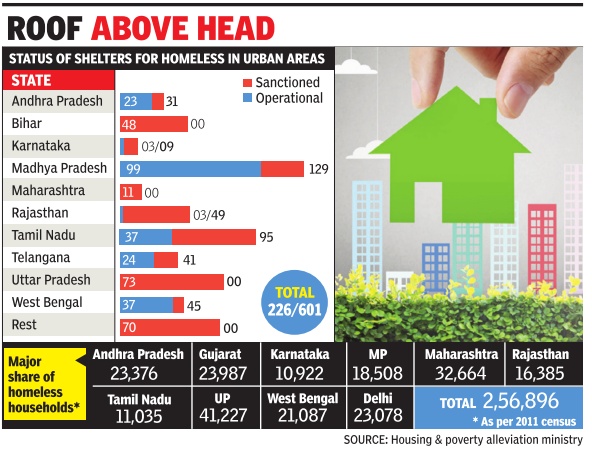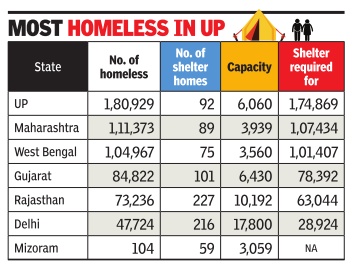Homeless people: India
This is a collection of articles archived for the excellence of their content. Readers will be able to edit existing articles and post new articles directly |
Contents |
Causes of homelessness
Marital violence top cause for women
Ambika Pandit, March 21, 2019: The Times of India
A study based on survivor accounts who have either lived or are currently residing in shelter homes in five states has highlighted that marriage related domestic violence is a primary cause for short and long-term homelessness of women.
It also turned out that most survivors were unaware of their right to residence under the Protection of Women from Domestic Violence Act.
The study also took into account women who are at risk of landing in shelter homes due to their vulnerable circumstances. Analysis of the accounts of 147 women survivors of violence from Delhi, north and south Karnataka, Assam, Meghalaya and Tamil Nadu and visits to 78 shelter homes shows that other reasons for which women were either abandoned or felt compelled to leave their families include sexual assault, old age, trafficking, opposition to women’s choices, abuse related to sexual orientation and physical and mental health issues.
Titled — “Survivor Speak — Call for Action from Five States” the report draws out common findings from the state specific reports to highlight the concerns of women who live or have lived in shelter homes being run by NGOs under the government schemes like the Swadhar Greh scheme.
Aimed at making shelters empowering spaces that offer rights-based support system to women, civil society networks came together in 2016 to form a diverse national network Lam-Lynti Chittara Neralu (an amalgamation of three languages Khasi, Telugu and Kannada that means to lead the way under the vista of stars). “The ground research on shelter is seen as a step to highlight the concerns raised by the survivors,” lead researcher from the network, Dr Amrita Nandye, said.
For most survivors of violence moving to a shelter home was only seen as a last resort. The reasons that kept women away from taking refuge in a shelter were separation from children, a sense of alienation they experience in shelters and curbs on communication and mobility.
Night shelters
2014-15 statistics
The Times of India Jan 02 2016

Dipak Dash
There may be a growing concern for homeless across big cities during winters, but progress in construction of night shelters has been very slow across most of the states despite the Centre providing 75% of funds required for building and refurbishing shelters for the urban homeless.
Government data shows, till mid-November, 601 shelters were sanctioned under the “Shelter for Urban Homeless“ (SUH) while only 226 were operational. States that have better record of implementing the projects are Madhya Pradesh, Tamil Nadu, Telangana, West Bengal and Andhra Pradesh, While Uttar Pradesh, Bihar, Maharashtra, Kerala and Punjab are yet to build a single such shelter.
“We share 75% of the total cost involved in construction, refurbishment of abandoned government buildings and even for their maintenance for five years. All these projects are sanctioned under the National Urban Livelihood Mission (NULM),“ a housing and poverty alleviation ministry official said. sion of Central assistance for building night shelters has been there for a few years, both Centre and states took interest only after the apex court pulled them up for failing to provide shelter to the most vulnerable sections of the society .
In November 2014, the apex court had asked the Centre to find ways to provide temporary shelters for the homeless and directed it to hold a meeting with states to prepare an action plan. The issue is to be heard by the SC next week when the action plan will be submitted.
Urban homelessness increasing
India’s urban homeless increasing rapidly
Rohit PS, TNN | Aug 14, 2013
More than a lakh of India's urban population became homeless in the decade 2001-2010, according to a census summary, which experts attribute to large scale migration from rural areas to cities.
The data also shows that numbers of urban homeless are more compared to the rural homeless population, which began to decline since 2001.
Urban India now has 9.42 lakh homeless people, an increase of 1.64 lakh over 2001 census figures. The increase has caused urban homeless numbers to exceed that of rural homeless population, a reversal compared to 2001, when the urban population was 7.78 lakh and rural population was higher at 11.65 lakh.
"Migration is the primary cause for an increase in country's urban homeless and a decline in rural homeless population. Many people who migrated for jobs find work but do not have houses to live in," D H Pai Panandikar of RPG foundation, a New Delhi-based economic think-tank, told TOI.
NCT [NCR] Delhi recorded a whopping 95.5 growth rate in its urban homeless population in the last decade, data shows.
"The migrant population is so high in Delhi, that the government admits that it is unable to cope with the influx from rural areas," Panandikar added.
Among the southern states, Andhra Pradesh recorded the highest growth in urban homeless.
The figures show that compared to 2001, the number of urban homeless people was higher by 13.5 percent decade on decade in 2011.
Tamil Nadu on the other hand showed a steep decline of 35% during the decade. Kerala and Karnataka also fared better than AP.
State-wise data shows Uttar Pradesh recorded a decade on decade growth rate of 87.2 and Chandigarh recorded 54.2 in the last decade. Rajasthan, West Bengal, Gujarat, Andhra Pradesh, Maharashtra and Kerala in addition to most northeastern states, have all recorded increasing growth rate in urban homeless population.
States with declining rates of homeless population
Some states showed a decline in rate of homeless population, with Tamil Nadu recording 35 percent and Karnataka, Goa and Bihar, also showing declining rates.
N Bhaskar Rao of Centre for Media Studies in Hyderabad said rural housing initiatives by governments are more in number compared to urban schemes.
"Rural housing and living conditions have been better addressed by governments through state and central schemes. It's a myth that urban population lives better. The living conditions of the urban poor are in fact worse than that of rural poor," he said.
Rights
Unlike Karnataka and Tamil Nadu, AP's urban homeless do not have adequate backing of rights based non-governmental organizations, explained Ananth Maringanti of Hyderabad Urban Labs.
"There is an absence of strong housing rights movement in AP. Also, real estate developers in urban areas of the state who have to earmark a tenth of their development space for low income housing, violate the norm. The crisis is aggravated by large scale evictions in urban areas like Hyderabad and Visakhapatnam," he said.
Rural homeless decrease
On a positive note however the country's total homeless population recorded a decrease, as the rural population came down by more than two lakh in the last decade. India now has 18.2 lakh homeless people, a decline of 8% over 2001.
Urban homeless

`50% Of Funds Released Under NULM Untouched By States'
A Supreme Court-appointed panel headed by a former Delhi high court judge has projected a very grim picture for urban homeless people saying that over 90% of them have no roof over their heads as state governments have failed miserably in setting up shelter homes despite the Centre releasing more than Rs 2,000 crore since National Urban Livelihoods Mission (NULM) was launched in 2013.
The three-member committee headed by Justice (retd) Kailash Gambhir submitted its report before the SC on the state of affairs of shelter homes in different states and said that as governments were not using funds the homeless in urban centres were forced to live on the roadside, railway platforms or under flyovers. It said only Delhi and Mizoram have done fairly well in providing shelters to such people.
As per the report, Delhi provides shelter to the largest number of homeless people in the country and in Mizoram the capacity of shelter homes outnumbers the homeless people in the state. UP, Maharashtra, West Bengal and Gujarat are the worst performers.
Lack of shelter leads to unnatural deaths in during peak summer and winter months.The apex court has been monitoring implementation of NULM and has repeatedly expressed concern over “an extremely unsatisfactory state of affairs on the ground“. It appointed the committee to after the Centre informed the court that around 50% of the Rs 2,185 crore released have not been utilised by states. The scheme covers 790 cities where state governments are to build permanent, all-weather shelters for urban homeless with basic infrastructure like water supply , sanitation, safety and security .
As per the 2011 census, of the 17.73 lakh homeless in the country , around 10 lakh are in urban areas. As much as 65.3% of homeless live in the states of UP , Maharastra, Rajasthan, Madhya Pradesh, Andhra Pradesh and Gujarat.
“The ministry of housing & urban poverty alleviation has laid down 2022 as the target year to provide shelter to each and every urban homeless in the country ... the road ahead appears to be very tardy and arduous, looking into the slow progress of establishing shelter homes by various States UT's,“ the panel's report said.
“During our visits to statesUTs the general impression was that there is lack of will on the part of states... The construction of the shelters is mostly being carried out as a farce exercise without fully complying with the guidelines and parameters laid down under the NULM,“ it said.
The panel said many homeless people preferred to live on the streets as the shelters are inhabited by drug addicts.It asked the court to pass orders asking states to appoint trained managers to look after the affairs of shelter homes.